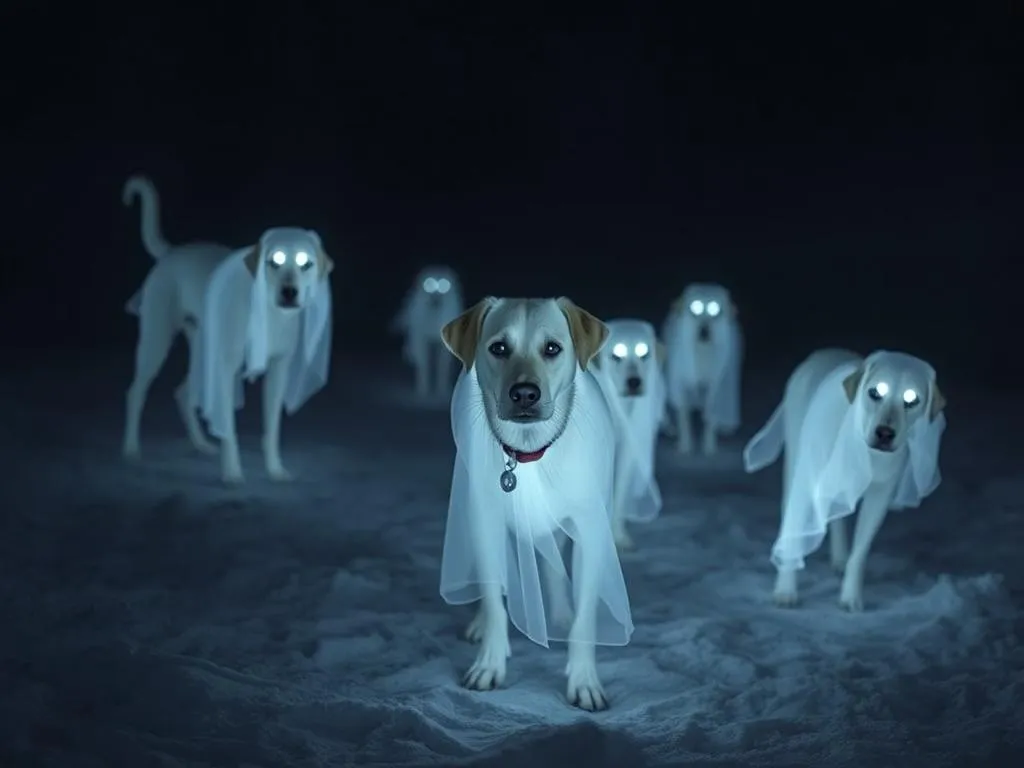
Introduction
Imagine sitting quietly at home, when suddenly your dog begins to bark at an empty corner of the room, tail stiff and hackles raised. This phenomenon has led many pet owners to wonder: can dogs see ghosts? It’s a captivating question that intertwines our love for dogs with ancient beliefs about the supernatural.
The fascination with the idea that dogs might possess a sixth sense has permeated cultures and generations. While some see it as mere superstition, others believe there might be a kernel of truth to the idea that our furry companions can perceive things beyond human understanding. This article aims to explore the popularity of the belief that dogs can see ghosts, delve into the scientific perspective, and examine the anecdotal evidence surrounding this intriguing topic.
In the sections that follow, we will uncover the complexities of canine senses, the cultural significance of ghosts, the behaviors of dogs around perceived apparitions, and insights from experts in the field. We’ll also touch on the psychological aspects that influence pet owners’ beliefs. By the end, you’ll have a comprehensive understanding of whether dogs can indeed see ghosts or if their behavior can be explained by more earthly phenomena.
Understanding Canine Senses
Overview of Dog Senses
When exploring whether dogs can see ghosts, it’s essential to first understand how dogs perceive the world around them. Unlike humans, who rely heavily on sight, dogs utilize a combination of senses that can detect stimuli we often miss.
- Sight: Dogs see fewer colors, primarily in shades of blue and yellow, but they excel in detecting motion.
- Smell: Dogs have an incredible sense of smell, estimated to be 10,000 to 100,000 times more sensitive than humans.
- Hearing: Canines can hear frequencies ranging from 40 Hz to 60 kHz, far beyond the human range of 20 Hz to 20 kHz.
This disparity in sensory perception raises the question: if dogs can detect stimuli we cannot, could they also sense the supernatural?
Dogs’ Vision
A common misconception is that dogs see the world in black and white. While they do have limited color perception compared to humans, their vision is adept at detecting motion, especially in low light. Dogs possess more rod cells in their retinas, allowing them to see in dim light better than we can.
- Color Perception: Dogs primarily see blue and yellow hues, lacking the ability to distinguish between reds and greens.
- Night Vision: Their ability to see in the dark is due to a layer of tissue called the tapetum lucidum, which reflects light back through the retina and enhances night vision.
This heightened ability to perceive movement, especially in the dark, might lead dogs to react to unseen phenomena, which some interpret as them sensing ghosts.
Dogs’ Hearing
Dogs are extraordinary in their ability to hear sounds that are imperceptible to humans. They can detect high-pitched frequencies that often escape our notice.
- Range of Frequencies: While humans can hear sounds up to 20 kHz, dogs can hear up to 60 kHz.
- Significance of High-Pitched Sounds: This capability means dogs can hear noises from appliances, electronic devices, or even the distant sounds of wildlife that we might not be aware of.
It’s possible that a dog’s unusual behavior—barking or growling at seemingly empty spaces—could be a response to these sounds, leading some to speculate about their ability to sense ghosts.
Dogs’ Sense of Smell
Perhaps the most formidable sense dogs possess is their sense of smell. Dogs have approximately 220 million olfactory receptors in their noses, compared to about 5 million in humans. This extraordinary sense allows them to detect scents in microgram quantities.
- Olfactory System: Dogs’ brains are structured to process smells more effectively than humans, allowing them to differentiate between countless scents.
- Environmental Understanding: Dogs use their sense of smell to navigate their environment, identifying familiar scents and detecting changes in their surroundings.
The ability to detect scents imperceptible to humans could explain some behaviors that pet owners interpret as sensing the supernatural.
The Concept of Ghosts and the Supernatural
Cultural Perspectives on Ghosts
Ghosts have been a part of human culture for millennia, with various interpretations depending on the society. Cultural beliefs greatly influence perceptions of ghosts, shaping how they are viewed in folklore and everyday life.
- Historical Significance: From ancient Egyptians’ mummification practices to the ghost stories of medieval Europe, cultures worldwide have sought to understand the presence of the deceased.
- Modern Interpretations: Today, beliefs about ghosts range from spiritual encounters to mere psychological phenomena, reflecting our fascination with the afterlife.
These cultural narratives often intertwine with our understanding of pets, particularly dogs, who are perceived as sensitive to the unseen.
The Science of the Supernatural
While many people believe in ghosts, the scientific community often approaches these phenomena with skepticism.
- Paranormal Research: Numerous studies have sought to investigate ghost sightings and experiences, often attributing them to environmental factors, such as electromagnetic fields, infrasound, and psychological triggers.
- Common Theories: Some theories suggest that ghost sightings result from the brain’s response to stress, fatigue, or even the influence of hallucinogenic substances.
Understanding these scientific perspectives can help debunk myths while also highlighting the human propensity to search for meaning in unexplained events.
Why We Believe in Ghosts
Belief in ghosts can often be traced to psychological and sociological factors.
- Personal Experiences: Individuals who have experienced loss may be more inclined to believe in ghosts, attributing signs from their deceased loved ones to supernatural occurrences.
- Media Influence: Movies, TV shows, and literature have perpetuated the idea of ghosts, often intertwining them with our beloved pets to heighten emotional connections.
This blend of personal experience and media portrayal fosters an environment where beliefs about dogs seeing ghosts can flourish.
Dogs and Their Behavior Around Apparitions
Common Behaviors in Dogs
When it comes to interpreting a dog’s behavior as possibly sensing ghosts, there are several common actions that pet owners observe.
- Barking: A sudden burst of barking at an empty corner might lead one to believe the dog is sensing something unseen.
- Growling or Staring: Intense staring or low growls can indicate that a dog feels something is off in their environment.
- Unusual Body Language: A dog’s body language can change dramatically in response to perceived threats, including crouching, raising hackles, or showing submissive behavior.
These behaviors can be perplexing and often lead to speculation about the supernatural.
Anecdotal Evidence
Anecdotes abound regarding dogs exhibiting unusual behavior in supposedly haunted locations.
- Haunted Houses: Many stories recount dogs barking at empty spaces or seeming to interact with invisible entities in homes believed to be haunted.
- Personal Testimonials: Pet owners often share experiences where their dogs reacted to unseen forces, furthering the belief that dogs might perceive ghosts.
While these stories are compelling, they are not universally accepted as evidence of supernatural ability.
Scientific Explanations for Behaviors
There are often scientific explanations behind the behaviors that may be interpreted as sensing ghosts.
- Hearing Sounds: Dogs may react to sounds that are inaudible to humans, such as high-frequency noises emitted by electronic devices or animals outside.
- Environmental Changes: Fluctuations in temperature, air pressure, or even the presence of certain chemicals can trigger a dog’s acute senses, prompting unusual behavior.
Understanding these explanations can help demystify the actions of dogs and challenge the notion that they are interacting with the supernatural.
Expert Opinions and Research
Veterinarians and Animal Behaviorists
Veterinarians and animal behaviorists provide valuable insights into canine perception and behavior.
- Professional Perspectives: Many experts agree that dogs possess heightened senses that allow them to detect stimuli we cannot perceive, but this does not imply they can see ghosts.
- Behavioral Analysis: Understanding a dog’s behavior often requires looking at their environment and potential triggers that could explain their reactions.
While some professionals remain open to the possibility of dogs sensing the supernatural, most lean towards rational explanations rooted in science.
Paranormal Investigators
Paranormal investigators often explore the connection between dogs and ghostly activity.
- Investigative Insights: Many investigators report that dogs can exhibit heightened sensitivity in locations with a reputation for supernatural occurrences, often being more alert than humans.
- Case Studies: There are documented cases where dogs have acted differently in haunted settings, leading investigators to believe they may sense something unusual.
The role of dogs in paranormal investigations adds an intriguing layer to the discussion, although it remains largely anecdotal.
Studies on Animal Senses
Research into animal senses continues to evolve, with some studies focusing on how animals react to unexplained phenomena.
- Scientific Research: Studies have explored dogs’ ability to detect changes in their environment, such as shifts in electromagnetic fields or chemical signals.
- Research Findings: While findings may hint at dogs’ acute perception, they do not conclusively support the idea that dogs can see ghosts.
These studies emphasize the need for further research to fully understand the complexities of canine perception.
The Psychology of Pet Owners
Pets as Family Members
The bond between pets and their owners significantly influences perceptions of a dog’s abilities.
- Emotional Connections: Many pet owners view their dogs as family members, attributing human-like qualities to them, including the ability to sense emotions and events beyond their understanding.
- Grief and Loss: When a pet owner experiences loss, they may seek comfort in the idea that their dog can communicate or sense the presence of the deceased.
This emotional connection can create a fertile ground for beliefs about dogs sensing the supernatural.
The Impact of Stories and Media
Stories and media representations play a crucial role in shaping perceptions of dogs and ghosts.
- Cinematic Influence: Movies, television shows, and literature often portray dogs as guardians or companions in the realm of the supernatural, reinforcing the belief that they can see ghosts.
- Social Media: Platforms like Instagram and TikTok amplify these tales, allowing pet owners to share their experiences and perpetuate beliefs surrounding canine abilities.
The media’s portrayal of dogs in supernatural contexts perpetuates a cultural narrative that influences public perception.
Coping Mechanisms and Beliefs
For many pet owners, the belief that dogs can see ghosts serves as a coping mechanism.
- Comfort in Belief: The idea that a beloved pet can sense the presence of a deceased loved one provides solace during difficult times.
- Psychological Effects: Believing that dogs can communicate with the supernatural may help some individuals process grief and maintain a connection with lost loved ones.
Understanding these psychological aspects can offer valuable insights into why beliefs about dogs and ghosts persist.
Conclusion
In summary, the question of can dogs see ghosts remains a captivating topic that blends science with belief. While dogs possess remarkable senses that allow them to perceive the world in ways we cannot, there is no concrete evidence to support the idea that they can see ghosts.
The behaviors exhibited by dogs—whether it be barking at empty corners or staring into the void—can often be explained by their heightened senses and their ability to detect stimuli beyond human perception. The cultural significance of ghosts, the influence of media, and the emotional bonds between pets and their owners further complicate this intriguing question.
As we continue to explore the depths of canine perception and the mysteries of the supernatural, it is essential to approach the topic with a blend of curiosity and skepticism. Ultimately, whether or not dogs can sense ghosts may remain a question open to interpretation, shaped by personal beliefs and experiences.









